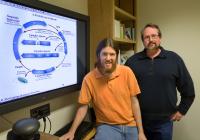
Adam Arkin and Morgan Price with model of operon life cycleIn a breakthrough that will immediately benefit biologists who study bacteria, a team of researchers has determined the life cycle of operons, small groups of genes with related functions that are co-transcribed in a single strand of messenger RNA. These results could also in the future have bearing on the advancement of the emerging field of synthetic biology, in which microbes are genetically engineered to make specific products, such as new medicines or pharmaceutical drugs.
Present in all known bacterial genomes, operons play a crucial role in gene expression programs that enable microbes to adapt to environmental stresses. This research was conducted by scientists with the U.S. Department of Energy's Lawrence Berkeley National Laboratory (Berkeley Lab), the University of California at Berkeley, and the Howard Hughes Medical Institute (HHMI).
In a paper published in the June 2006 edition of the Public Library of Science's Genetics section, entitled The Life-Cycle of Operons, the researchers describe a study in which the genome of Escherichia coli was compared to Salmonella typhimurium and other close relatives, in order to identify recently formed and destroyed operons. The results showed that both operon creation and destruction lead to large changes in gene expression patterns, suggesting that operon evolution reflects a microbe's adaptation to differing lifestyles.
"Part of what determines the birth and death of operons is the need to generate gene expression patterns in new or changing environments," said Adam Arkin, a computational biologist who led this research. "It might be intuitive that bringing two related genes into an operon could be adaptive for the regulation of a pathway, but we found that the death of old operons may also be driven by the need for new and different regulation of key genes."
Arkin is a member of the Department of Computational and Theoretical Biology in Berkeley Lab's Physical Biosciences Division, a UC Berkeley professor in bioengineering, and an HHMI investigator. Coauthoring the PLoS paper with him were Morgan Price and Eric Alm, while all three were affiliated with the Virtual Institute for Microbial Stress and Survival at Berkeley Lab
Operons are widespread in the genomes of all prokaryotes, archaea as well as bacteria. In the typical prokaryote genome, about half of all the protein-coding genes are located in operons. Genes that are placed together in operons can vary widely across different types of microbes. Also, genes that are in the same operon in one bacterium are often found in different operons in other bacteria. The diversity of operon structures, which affects the regulation of gene expression, has been used to predict the function of genes, but, until now, biologists have not really understood why this diversity exists. The consequences of structural diversity in operons have also been unclear.
"Why are operons so prevalent? The traditional view has been that genes are placed in the same operon so that they will have similar expression patterns," said Arkin. "This also explains why operons tend to contain functionally related genes and why genome rearrangements that would destroy operons are strongly selected against. However, although genes in the same operon mostly do have similar expression patterns, genes can also be co-regulated without being in the same operon."
To answer questions about operon structural diversity, Arkin, Price and Alm examined newly formed and recentlydeceased operons of Escherichia coli K12, and compared orthologous operons in Salmonella typhimurium LT2. They also repeated some of their analyses of operon evolution for Bacillus subtilis. Their findings shed new light on how new operons form, how spacing among their constituent genes evolves, and how they die.
In addition to showing that operon evolution is being driven by selection on gene expression patterns, the researchers also showed that some operons undergo accelerated evolution, with multiple new genes being added during brief periods of time. They also found that although genes within operons are usually closely spaced,genes in highly expressed operons may be widely spaced because of regulatory fine-tuning by intervening sequences.
"Operon evolution may be adaptive, but it need not be optimal," the authors state in their PLoS paper. "New operons often comprise functionally unrelated genes that were already in proximity before the operon formed."
Arkin, Price and Alm used their findings to create a model for operon evolution which they believe will encourage other biologists to re-think their views on the role of operons in the adaptation of microbes to theirenvironment.
"Our model of operon evolution should affect how biologists infer function for uncharacterized genes and how the results from future studies of operon structure or gene regulation are interpreted," Arkin said. "For example, there are immediate applications for the practice of annotating bacterial genomes in that 'new' operons are less likely to give high-quality results for functional inference as 'old' operons would. Also, the ability to predict operons and their evolution should lead to better approaches for detecting groups of genes which work together to perform a cellular function."
Down the road, the operon evolution model should also benefit synthetic biology research, as Arkin explained.
"Synthetic biologists always need new parts, so our work will ultimately spillover to them too," he said. "Ultimately we believe it will be possible to infer how different regulatory strategies and operon architectures are being evolutionarily selected and thereby learn what might be good synthetic designs for cellular circuits."
Source : DOE/Lawrence Berkeley National Laboratory
 Print Article
Print Article Mail to a Friend
Mail to a Friend
